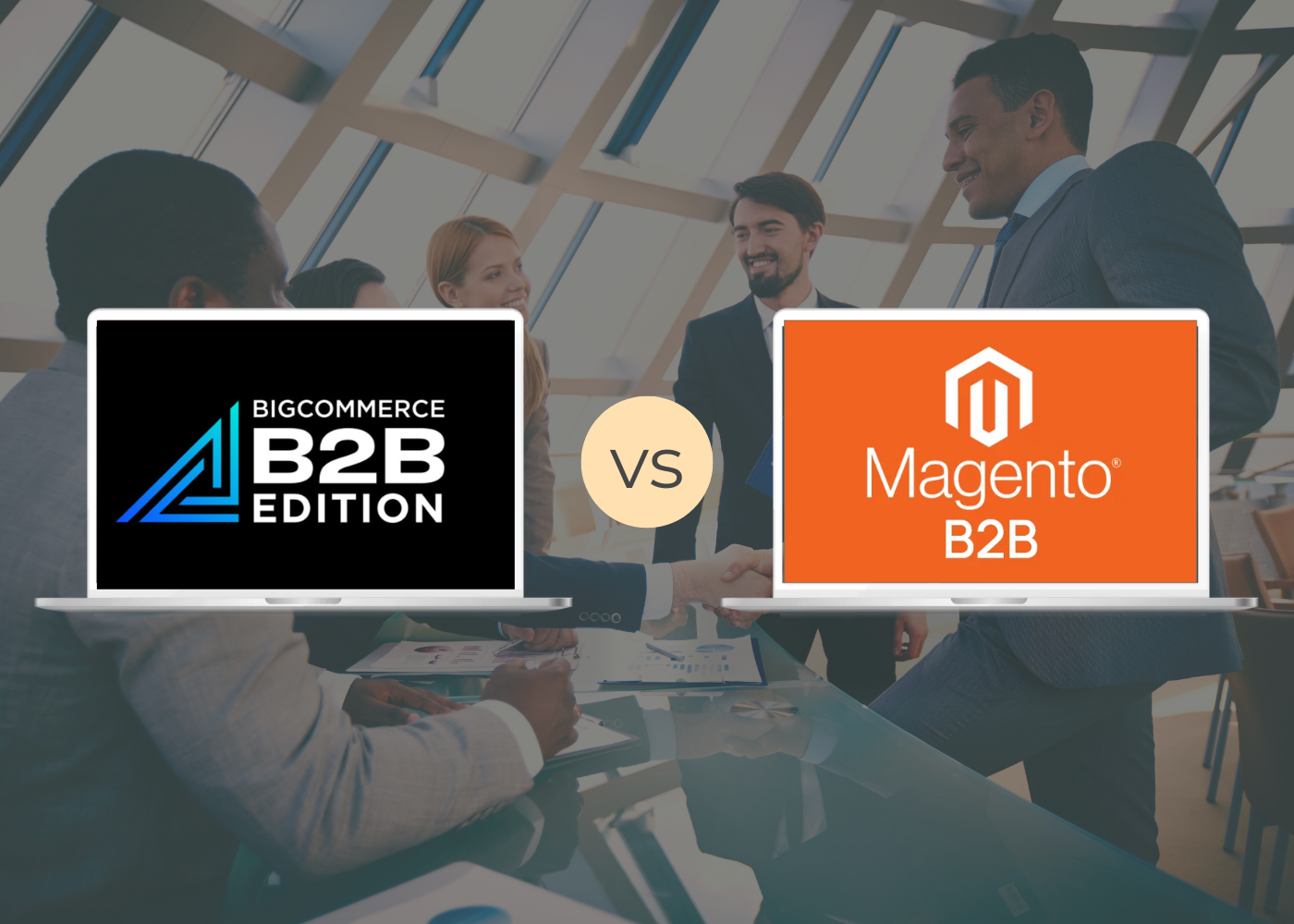Start or grow your B2B eCommerce store with this information-packed guide.
Getting started with B2B eCommerce can be daunting, especially if you’re moving from B2C into a hybrid approach or from a brick-and-mortar business to an eCommerce seller.
There’s a lot of information to sift through and even more to learn. We put together this B2B eCommerce guide to help you navigate the process, making it less intimidating.
While there is a lot to learn about starting or growing a B2B eCommerce business, there are also a lot of opportunities.
For instance, according to the Insider Intelligence report from eMarketer.com, “We forecast B2B eCommerce site sales will reach nearly $1.77 trillion in 2022, a 12% increase from a year prior.”
Additionally, the forecast for 2023 is an 11.8% increase over 2022’s forecast — so there’s ample B2B eCommerce opportunity.
Additionally, B2B eCommerce is growing exponentially in the US and globally, according to this July 2022 Statistica.com report:
- Global eCommerce Gross Merchandise Volume (GVM), 12.2 Trillion
- B2B eCommerce Volume in the US, 6.7 Trillion
- eCommerce share of total B2B sales in the US, 13%
Want a portion of future B2B eCommerce growth? You’ll need a solid plan to get there. Use the information in this guide to ensure your B2B eCommerce business succeeds.
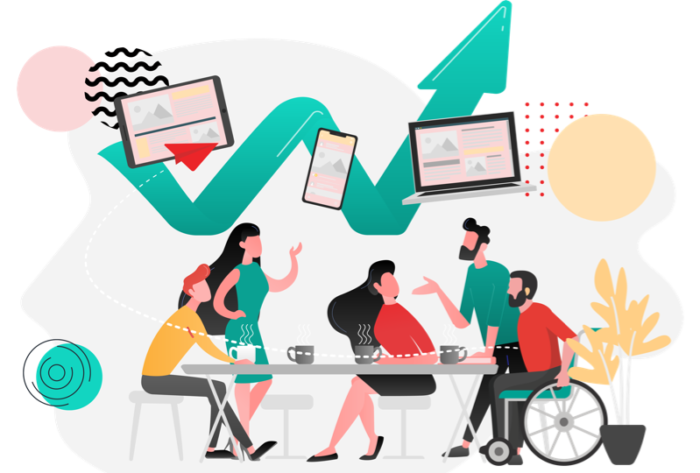
Here’s what this guide covers:
Table of contents
- What is B2B eCommerce?
- What is the difference between B2B and B2C eCommerce?
- What are the advantages of B2B eCommerce businesses?
- What are the disadvantages of B2B eCommerce businesses?
- How does B2B eCommerce work?
- What are the Types of B2B eCommerce Businesses?
- B2B eCommerce Best Practices
- B2B eCommerce Marketing Tips
- How to get started with B2B eCommerce
- Best B2B (Business-to-Business) eCommerce Platforms
- B2B eCommerce Website Examples
Let’s get started.
What is B2B eCommerce?
B2B eCommerce, or business-to-business eCommerce, is when one business sells its products or services to another company via an online store or platform.
Whether the products sold online are digital or physical or the services are delivered in-person or virtually, transactions processed via online sales platforms, from one business to another, are B2B eCommerce transactions.
What is the difference between B2B and B2C eCommerce?
B2B and B2C eCommerce businesses are different, but how — and does it matter?
While there are a lot of similarities, there are some distinct differences, too.
B2B eCommerce
B2B eCommerce is the sale of products or services from one business to another. B2B eCommerce businesses can sell directly to their business customers or go through a third party.
For instance, some B2B transactions go through a wholesaler or distributor, while others go to a business customer.
While B2B eCommerce websites are more complex than B2C, they shouldn’t be. More and more B2B customers are demanding the same functionality and experiences as B2C customers.
After all, they are B2C customers in their personal lives, so they’ve grown accustomed to certain features and functionalities — why shouldn’t they have those in their B2B experiences?
Complexities with the B2B Purchasing Experience:
Price Point: B2B buyers are buying higher-ticket products and making higher-volume orders requiring more approvals. Plus, they typically have strict budgets with constraints.
Decision-making: B2B buyers usually make purchases with long-term planning (quarterly and yearly).
Circle of influence: Because B2B buyers make decisions for large groups of people, their buying cycles can be lengthy.
B2C eCommerce
B2C eCommerce, or business-to-consumer eCommerce, sells products and services from a business to a customer. For instance, B2C customers purchase clothing directly from retailers like Walmart, Target, or Macy’s.
B2C eCommerce websites and associated experiences are more straightforward and user-friendly than B2B customers. Interestingly, B2C customer experiences are disrupting the traditional B2B online experience. B2C customer experiences include flexible payment options and personalized promotions, etc.
Simpler B2C Buying Process:
Price-Point: Except for houses and cars, B2C customers generally make lower-ticket and lower-volume purchases, so budgets are smaller and much more flexible.
Decision-making: B2C customers can make impulse buys or have shorter planning periods (daily, weekly, and monthly)
Circle of influence: B2C customers buy for individuals or small groups of people. They routinely buy the same items, so decision-making and shopping are much faster than B2B customers.
Now that we’ve discussed the differences between B2B and B2C eCommerce businesses, let’s talk advantages and disadvantages of eCommerce businesses.
What are the advantages of B2B eCommerce businesses?
The tangible benefits of operating a B2B eCommerce business are undeniable. Here are a few:
Improves operational efficiency for buyer and owner
Whether logistics, finance, or inventory management, having a central eCommerce portal can simplify business management for the owner and purchasing management for the buyer. Everything in one location makes storing communications, documents, and order histories easier.
Expand market reach and customer Base
Grow your business with new customers. Becoming a B2B eCommerce business or adding it to your existing B2C customer base can grow your business exponentially. With a solid B2B platform and the proper marketing, you’ll have the power to reach, attract and sell to new B2B customers.
Flexible, Single-Platform Product and Service Offerings
With the right B2B eCommerce platform, you can sell products and services to B2B and B2C customers. Start small with B2B products only. When ready, add complementary services. Additionally, online payment processing improves payment processing and operational efficiency.
What are the disadvantages of B2B eCommerce businesses?
1. Complex Buyer’s Journey for Customers
The steps from quote to purchase are much more complicated in the B2B customer’s journey. From customized pricing to purchase order authorizations, B2B customers need highly customized options, which can vary from customer to customer. So, a flexible B2B platform that can work with these constraints is necessary.
2. Long, Multi-Step Sales Process
The sales process is on the flip side of the buyer’s journey — and the B2B sales process has layers of complexities. Because of the types of products and costs, B2B sales process often involves significant facetime, multiple meetings, and lots of information to get the sale, which takes time. Because of this, time to pay may seem delayed or slow compared to the B2C sales process, which is much faster.
3. No One-Size-All eCommerce Platform
Because each B2B customer might have different requirements for purchase processing, an off-shelf eCommerce platform implementation may not work for many of your customers and will require some customization. The key here is to choose a platform that is flexible enough to support your B2B customers’ needs.
How does B2B eCommerce work?
Generally, B2B transactions happen through an online sales portal. Whether a manufacturer sells to a wholesaler or a wholesaler sells to a retailer through a B2B online sales portal, the process requires a platform to facilitate the transactions.
What are the steps in the B2B buying or purchasing process?
In most cases, B2B transactions must go through formal — and sometimes lengthy — approval processes.
Because the B2B sales process can be complex and typically requires multiple steps and approvals, knowing what to expect can help you feel confident with B2B eCommerce transactions.
That said, here are simplified steps in the purchasing process:
Step 1: Problem or need acknowledgment
In this step, the customer becomes aware of the problem and will consider potential solutions at a high level. Informal meetings with internal stakeholders to discuss the issues and ideate solutions typically happen at this stage.
Step 2: Product or service specifications
To resolve the issue, the customer will define the problem and identify the specific features and benefits of those products or services. Some customers will use these findings to create a business case for the proposed solution to present later at more formal stakeholder meetings.
Step 3: Customer supplier and product search
Here, customers search for available solutions to their problems. Most customers start by performing Google searches to find products, services, and suppliers that fit their needs. But remember, customers can only find your site if you’ve adequately optimized it.
Step 4: Product/Service Selection
Once customers decide on a supplier, they will further refine their search for products and services needed to resolve their issue from the supplier’s website. The order or purchase order (PO), sometimes referred to as a purchase authorization (PA), is created in this step.
Step 5: Approvals
The buyer creates the PO and sends it to the internal stakeholders for approval. Depending on the business, there may be several steps in the approval process.
Step 6: Purchasing and eProcurment
Once all the necessary internal stakeholders have approved the PO, the PO is sent to the vendor for fulfillment. The vendor then acknowledges and fills the order. Many suppliers use eProcurement solutions, like ProcurePort.com, to help streamline, automate, and track order fulfillment.
What are the Types of B2B eCommerce Businesses?
There are several types of B2B eCommerce stores for almost any transaction that can take place online. Here are the most common:
Manufacturers
Before goods can be sold, they must be manufactured. Manufacturers sell the products they produce to other businesses, like wholesalers, via an eCommerce website or platform.
Wholesalers
Wholesalers sell products — in bulk and at a discount — to other businesses. There are even online marketplaces, like Alibaba, where retailers can purchase goods from many wholesalers.
Examples: Amazon Business, X Cart, and Made in China
Distributors or 3PLs (Third-Party Logistics)
These distributors partner with their business clients to manage their end-to-end supply chains. They provide services like storing, managing, fulfilling, and shipping products on customers’ behalf.
Examples: Shopify Fulfillment, EasyShip, National Fulfillment Services
Retail
Retail eCommerce businesses buy merchandise from wholesalers and resell items to their customers at marked-up prices and for profit.
Examples: Uline, Primera, Beauty Solutions
Services (Software-as-a-Service or SaaS)
Software-as-a-Service or SaaS is a business model where access to software services via a license is usually paid upfront through a subscription for a designated amount of time (weekly, monthly, or yearly). To continue accessing the SaaS, the customer pays the business a recurring fee at scheduled intervals.
Examples: Adobe Creative Suite, SalesForce, Constant Contact
All of the above eCommerce businesses can fall into one of the following three business models:
Buyer-oriented marketplace
In this customer-controlled model, a large group or consortium of buyers get together to command better deals from suppliers. Buyers post requirements for the products and services they need, and qualified suppliers bid on the project.
The pooled buying power and bidding process can help reduce costs and administrative fees for buyers. The buyer-oriented marketplace is also called eProcurement.
Example: GE’s Electronic Bidding site (aka GE TPN Post).
Supplier-oriented marketplace
In this model, a supplier directory or marketplace focuses on selling products to many businesses at a time since there are many sellers and few buyers.
This model favors suppliers since there are so few suppliers they can dictate and command higher prices. This type of marketplace is also called a supplier directory or eDistribution.
Example: Cisco Connection Online
Intermediary-oriented marketplace
In this model, a third-party owner creates a platform that allows buyers and sellers to exchange goods and services.
Similar to the B2C model eBay, a B2B example is Mangtas. There, buyers and sellers sign up as clients or vendors, and the third-party owner acts as a middleman facilitating transactions.
Example: Etsy.com
B2B eCommerce Best Practices
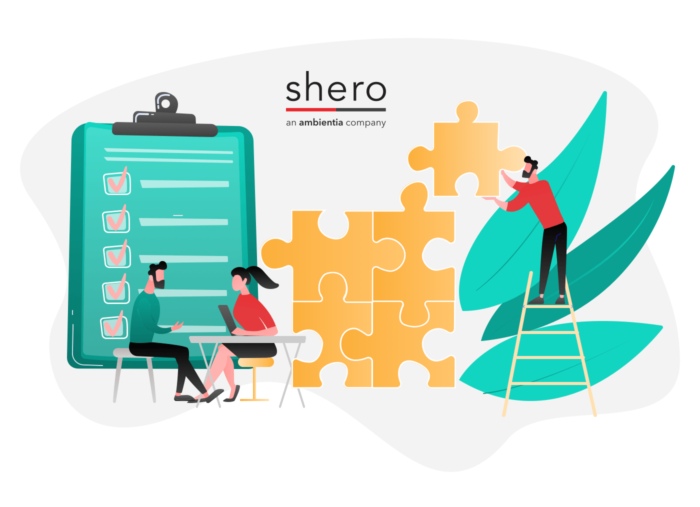
B2B Customers Want B2C eCommerce Experiences — So Give it to Them
B2B eCommerce is undergoing a rapid and exciting transformation. And with that transformation comes a profound change in customer expectations. B2B customers are not only expecting but demanding more B2C-like experiences.
How so?
According to a Sapio Research study, “94% of B2B buyers suffer from customer experience challenges when they buy online,” and “50% of eCommerce sites are not fully meeting the expectations of B2B buyers.
Gone are the days of placing orders by phone, waiting for invoices in the mail, and paying via check.
Today’s B2B customers prefer to self-serve via an online portal. Here’s how to give it to them:
- Mobile-friendly eCommerce storefronts
- Easy-to-navigate online catalogs
- High-quality product-related content (images, video, and information)
- Relevant onsite search and visual merchandising
- Flexible and accurate shipping fees
- Up-to-date and real-time stock availability
- Personalized promotions based on purchase history
- Trust signals and social proof (reviews, ratings, etc.)
- Easy payment processing (flexible payments, paperless invoices, etc.)
- Supplier sourcing and eProcurement
According to Sana’s 2022 B2B Buying Process Report, B2B customers’ top priorities are reducing costs, increasing buying process efficiency, and improving internal client satisfaction.
And, given that “67% of B2B customers prefer accessing product information online,” focusing on “ease and speed” are keys to winning with B2B eCommerce customers.
B2B eCommerce Marketing Tips
B2B eCommerce Search and Discovery: How Customers Find You
Maximize your brand awareness to generate interest in your B2B eCommerce business with the Search and Product Discovery phases and these digital marketing strategies:
The Search Phase:
Paid Search (PPC and Social Ads)
Paid Search is an excellent customer acquisition strategy, especially for new eCommerce sites or sites that haven’t developed or have just launched an SEO strategy but haven’t seen results yet. Since SEO is a longer play, paid search campaigns allow you to generate brand awareness and acquire customers through targeted pay-per-click ads.
eCommerce Search Engine Optimization (SEO)
Search engine optimization or SEO is the process of optimizing content on your eCommerce website to be easily found by searchers. You optimize your content for keywords directly related to your products. Ideally, when searchers enter the keywords into Google, your site is listed high on page one of the search engine results page (SERPs) — where customers can find you.
The Product Discovery Phase:
B2B eCommerce Website Optimization
Prospects finding you is only half the battle. Once they are in your store, make it easy for them to find and buy your products. To do that, remove any friction or obstacles that prevent you from getting the sale.
While B2B eCommerce websites share similarities with B2C eCommerce websites, there are differences — and those differences require B2B-specific knowledge to ensure optimal results.
Done right, optimizing your eCommerce site specifically for your B2B audience will make your site easy to do business with — and that’s always a great customer experience.
Here’s a list of B2B eCommerce optimizations to consider:
Merchandising or Internal Site Search Optimization
Internal search or site search optimization helps your customers find products more efficiently. At minimum, make sure you optimize the search results for your best-selling products.
Category Pages
Create useful content around your category pages to teach customers about product categories at a high level. You can also introduce and link to related subcategories. These tactics can help with SEO.
Subcategory Pages
Like categories, create content around subcategories. Then, link to your best-selling products; this helps customers and search engines.
Product Detail Pages (PDPs)
Product detail pages are a gold mine of opportunity — that most eCommerce sites miss. A simple detail like product dimensions can cost you a sale, so ensure product details are accurate and complete.
B2B Payment Processing
B2B customers have different purchasing processes than B2C customers. Many B2B customers have multi-step approval processes; some require POs or purchase order numbers. Make sure your eCommerce platform can handle B2B transactions properly.
B2B-Specific Discounts, Promotions, and Content
B2B customers have special needs, and your offers, promotions, and content should reflect that. Customizing the B2B experience will help th
Checkout Experience
The checkout process should not be an obstacle course. Instead, make sure each step is frictionless and error-free. Make it easy for customers to give you their money. Remember, sales are won or lost on the checkout pages. Make sure your checkout pages are winners.
Post-Purchase Experience
Customer acquisition is not only challenging, but it’s also expensive. So once you’ve acquired a customer, do your best to keep them. Send effective post-purchase emails to confirm the purchase and thank them for it. In follow-up emails, you can also send promotions about products related to their recent purchase(s).
To gain a competitive advantage for your B2B eCommerce business using Paid Search, eCommerce search engine optimization (SEO), or B2B eCommerce Website Optimization, book a Search Engine Marketing (SEM) or eCommerce Optimization consultation today.
How to get started with B2B eCommerce
Launching — or growing — an eCommerce business has many moving parts — and if you bite off more than you can chew, it can be overwhelming.
But it doesn’t have to be.
First, set a deadline. Then, list all the associated tasks (see the one below to get started). Once you have a completion date and a task list, plan out how many tasks must be completed per day to launch by the due date.
It’s your site; take your time or speed through it. Remember, you’re the boss, so make a plan that works for you.
B2B eCommerce Checklist
- Decide on a niche
- Choose a business name
- Get a business license, tax ID, and LLC (if needed)
- Buy a domain name
- Choose an eCommerce Platform and hosting
- Choose a template for your store
- Create a logo, header, and favicon
- Create categories and subcategories based on your product offerings
- Create content (copy, CTAs, images, and video) for your first 25 products
- Create content for the main pages (Not all have to be done now or at all):
- Home Page
- About us
- Blog
- Contact us
- FAQs
- Terms of Service
- Return Policy
- Privacy Policy
- Shipping Policy Page
- Design and test the checkout experience
- Set up and link to social media
- Choose apps to grow your business
- Setup Google Analytics and Google Search Console
Best B2B (Business-to-Business) eCommerce Platforms
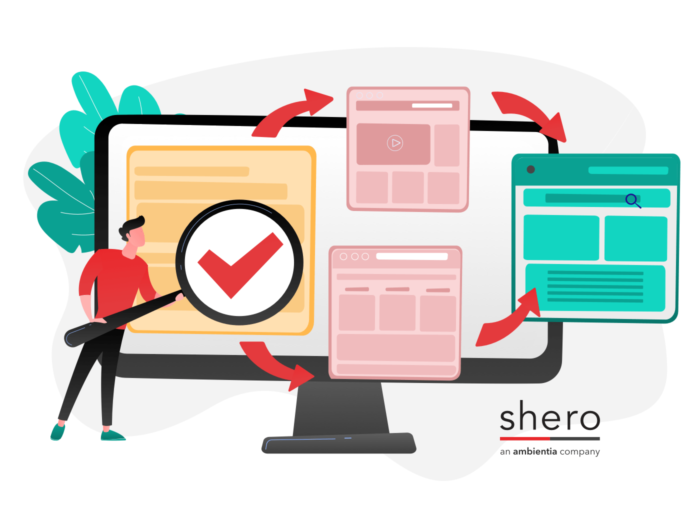
Shopify Plus
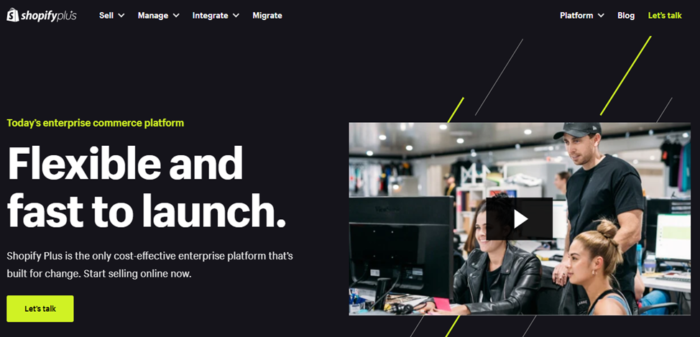
When you’re ready to scale your B2B eCommerce business, ShopifyPlus can get you there. From migrations and re-platforming to its Merchant Success Program, ShopifyPlus empowers you to reach your goals. Because of its high monthly fee of $2000, ShopifyPlus is designed for merchants with high-volume sales.
ShopifyPlus includes all the features of Shopify’s standard plans — Basic, Shopify, and Advanced — with some extras, like integrating custom apps through the API, the ShopifyPlus Partner Program, and flexible payments through Shopify POS. Plus, you can build multiple stores and manage them through a single admin console. There’s also a ShopifyPlus Facebook group for support.
Adobe Commerce
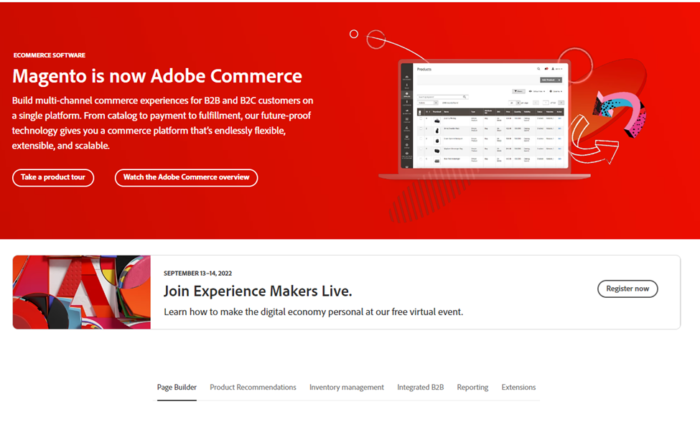
Adobe Commerce, formerly known as Magento, has powerful tools to help you start, grow, and scale your business — with seamless integrations with Adobe products like Creative Cloud, Test and Target, and Adobe Analytics. Pricing is not available on the website; contact Adobe.
Adobe Commerce can handle all your online commerce needs regardless of size or business model. Support both B2B and B2C customers on a single platform. With thousands of themes and extensions, this platform grows with your business. Also included are an easy drag-and-drop page builder, product recommendations, and inventory management.
BigCommerce
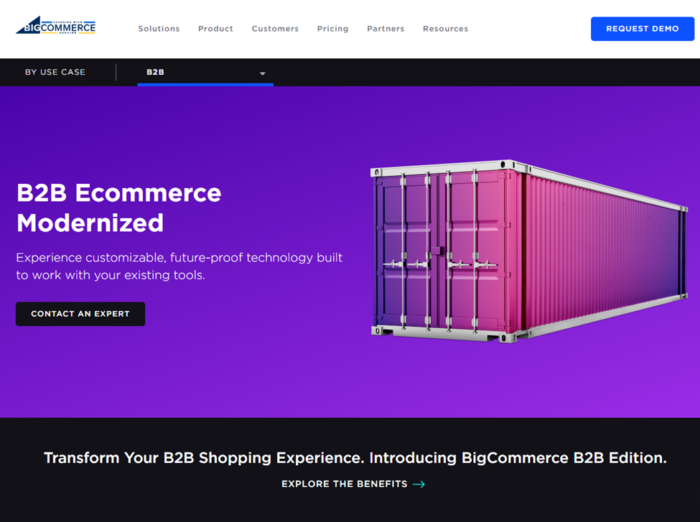
B2B customers expect more B2C-like shopping experiences; you can do that with Big Commerce. From user-friendly designs to large catalogs and SKU-level pricing segmentation, BigCommerce has the features to grow your business — as fast as you need to. Pricing is not available on their website; contact BigCommerce.
A B2B eCommerce platform must support unique purchasing flows — BigCommerce does this well. With B2B-specific payment pricing and payment processing — like punch out, purchase orders, and net payment term — get the functionality to serve B2B customers with ease. BigCommerce offers one-click integrations with apps and tools, B2B-friendly shipping, quote management, purchase order authorizations, and more.
WordPress/WooCommerce
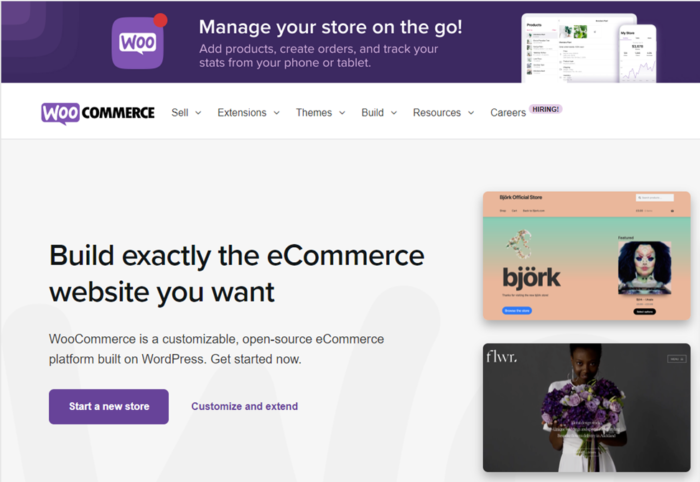
WooCommerce is a highly customizable open-source eCommerce plug-in used on the WordPress platform. Basically, using this plug-in adds eCommerce functionality to your existing WordPress implementation, whether you’re using it as a blog or a website. And for additional B2B functionality, add the extension for only $149.
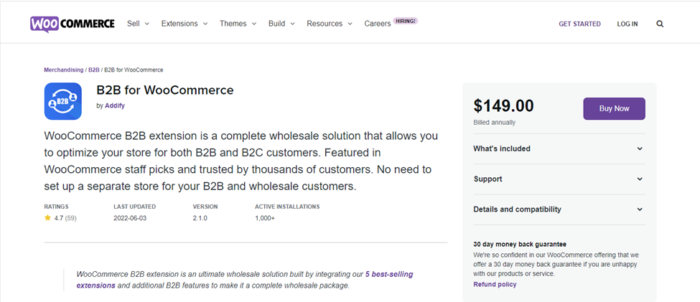
With B2B for WooCommerce, get B2B-specific features like customizable quote forms, customer-specific pricing, role-based B2B user registration forms, and more. Additionally, you can hide categories and products based on user roles. Look no further for a budget-friendly platform that can handle both B2B and B2C customers.
B2B eCommerce Website Examples
To illustrate everything we’ve discussed, looking at different B2B eCommerce website examples is a good idea.
Here are three examples to get started:
BerlinPackaging.com | eCommerce platform: BigCommerce
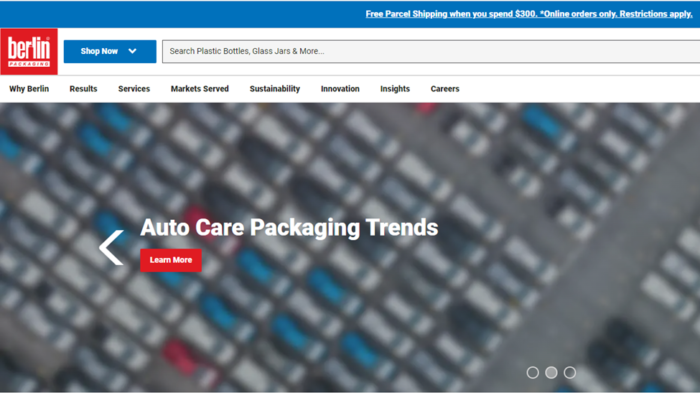
Berlin Packaging provides stock and custom plastic, glass, and metal packaging to businesses in every industry via their eCommerce store. There, customers can shop by market, function, and product type. Segmenting experiences by industry, for instance, allows Berlin Packaging to serve each industry’s specific needs with more personalized experiences.
Staples.com |eCommerce platform: ShopifyPlus
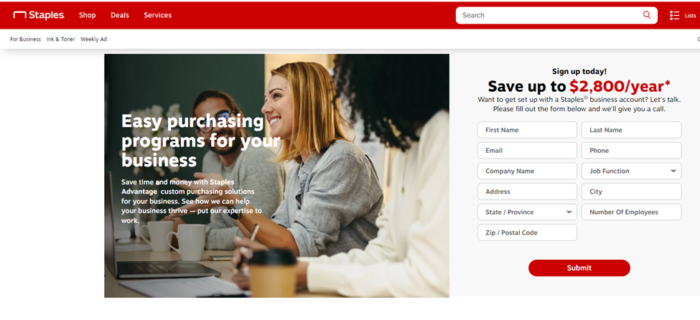
Staples sells office supplies to customers and businesses. By clicking the “For Business” link on the main website, customers are taken to the B2B experience. Once there, customers can view everything from business-exclusive pricing to easy procurement and flexible payment options.
RuralKing.com |eCommerce platform: Adobe Commerce (Magento Commerce)
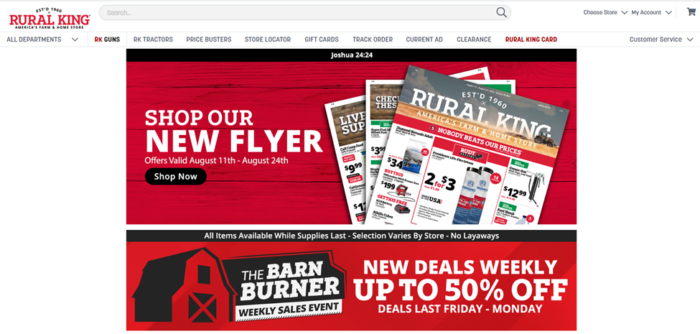
Rural King sells household, livestock, and farm supplies to farmers and families. On the
B2B side of the house, the Farm and Ranch category, farmers can do everything from custom building tractors to buying livestock feed. Intimately knowing their customers helped Rural Kings design a custom-made site for their customers, which shows.
Now that you’ve learned what it takes to run a successful B2B eCommerce business let’s kick it up a notch. Level up your success story with our top-notch digital marketing services.
Contact us today for a free, no-obligation consultation.
Gentian, CSO and co-founder of Shero Commerce, guides the company and client digital strategies. He's an expert in technical SEO, Inbound Marketing, and eCommerce strategy.




